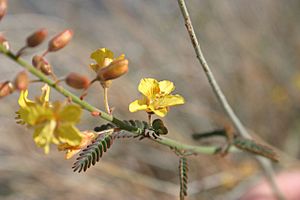Hoffmannseggia microphylla facts for kids
Quick facts for kids Hoffmannseggia microphylla |
|
|---|---|
 |
|
| Scientific classification | |
| Kingdom: | |
| (unranked): | |
| (unranked): | |
| (unranked): | |
| Order: | |
| Family: | |
| Genus: |
Hoffmannseggia
|
| Species: |
H. microphylla
|
| Binomial name | |
| Hoffmannseggia microphylla Torr.
|
|
| Synonyms | |
|
Caesalpinia virgata |
|
Hoffmannseggia microphylla is a special kind of flowering plant. It is also known by its common name, wand holdback. This plant belongs to the legume family, which includes peas and beans. It grows naturally in the deserts of the southwestern United States and Baja California. You can often find it in sandy or gravelly soil.
About the Wand Holdback Plant
The wand holdback is a type of shrub. A shrub is a woody plant that is smaller than a tree. It has many thin, branch-like stems. These stems can grow up to two meters (about 6.5 feet) tall. They often look like long, thin wands.
What It Looks Like
The stems of the wand holdback are green and have tiny hairs. For most of the year, these stems don't have many leaves. The plant is deciduous, which means its leaves fall off at certain times. Before they fall, the leaves look like small twigs. Each twig has pairs of tiny, oval-shaped leaflets.
Flowers and Fruits
The wand holdback plant produces beautiful flowers. These flowers grow in groups called racemes. They start out yellow with red streaks. As the flowers get older, they turn completely red.
After the flowers bloom, the plant grows fruits. These fruits are shaped like a sickle, which is a curved tool. They are called legume pods. Each pod can be up to 2.5 centimeters (about 1 inch) long. The pods feel bumpy and have small glands. They are also a bit hairy. When the pods are ready, they split open to release their seeds.

